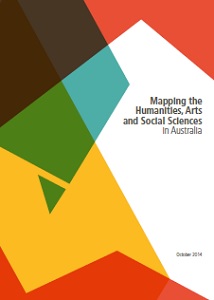教養学部報
第576号 ![]()
Mapping the Humanities, Arts and Social Sciences in Australia
アナ・ジョンストン(Anna JOHNSTON)
オーストラリアにおける学術景観─人文科学・社会科学の場合─
自然科学の諸分野における教育・研究の現状をグローバルな基準から検証する作業は国内外の大学で比較的進んでいる印象を持つ。しかし、人文科学・社会科学の諸分野においては、教育・研究の達成を測る世界共通の基準は生まれていない。そのような基準が存在し得るか否かが議論になっていると言ってよいだろう。それでも、例えば、論文の引用頻度や学会での報告数をもとにした人文科学・社会科学における教育・研究の評価基準づくりを英米の諸大学が近年試みている。学部学生の留学経験や教員の学術交流の回数もそうした評価基準に含まれる。一方で、そのような視点から学術の成果を計量的に評価する試みへの疑義・批判も強い。
それらの試みを評価する立場と批判する立場をともに踏まえながら、人文科学・社会科学の学術景観を検証する試みが2014年オーストラリアでなされた。授業に対する学生の需要や卒業生の進路、教員の年令別構成などもその学術景観のなかには含まれる。
本研究科アメリカ太平洋地域研究センターで活動するオーストラリア研究客員教授がその詳細を下に伝えてくれる。
遠藤泰生(グローバル地域研究機構/英語)
An important new study was released in late 2014, sponsored by the national Academies for Humanities and Social Sciences with Federal Government support: Mapping the Humanities, Arts and Social Sciences in Australia. (http://www.humanities.org.au/Policy Research/Research/MappingtheHumanitiesArtsSocialSciences.aspx) The report—by leading cultural studies scholar Professor Graeme Turner, with a senior academic steering committee—surveys the humanities, arts, and social sciences (the HASS sector) across the period 2002-2012, focussing on three key areas: teaching and learning; research; and academic workforce. Countering recent narratives of the humanities in crisis—a common feature of media reports from both the UK and the US—this report finds the Australian HASS sector to be vibrant and internationally engaged.

Web上に掲載された報告書Valuable quantitative research underpins this report, which exhorts evidence-based future planning by universities and government against a history of ad hoc, anecdotal, and reactionary decision making. The HASS sector is the largest component of Australian higher education: it enrols 65% of undergraduate and graduate students, in fields including creative industries (visual and performing arts, for example), traditional humanities (philosophy, history, and literature), and social sciences (international relations, management, and psychology). Like many international systems, Australian universities have increasingly engaged in measurement exercises, so it is now possible to provide compelling evidence of positive employment outcomes, for example. Within 4 years of graduation 95% of management and commerce graduates seeking full-time work had gained employment; 93% of education graduates; and 90% of society and culture graduates (including sociology, traditional humanities, and cultural studies). So too, HASS achieves high levels of student satisfaction: peaking at 89.7% of graduates in history, and 88.9% in literature. Academics often express reasonable concerns that “student satisfaction” measures may not reward difficult but important scholarship. Yet the fact that students express confidence in the value of their degrees, and relevance for their subsequent careers, must provide succour for even the sharpest critics of neo-liberal education.
Australian higher education has faced some intense challenges during the past decade, and these are likely to be instructive for Japanese colleagues. A demand-driven system is producing ongoing if somewhat unpredictable change. In 2012, the government lifted previously imposed limits on the public funding of bachelor-degree students to increase participation, improve access for students from poorer backgrounds and rural / regional areas, and meet the skills needs of modern economies. (Australia’s 38 public and 4 private universities now enrol over 1 million students.) Effectively, institutions are encouraged to tailor their offerings to meet student demand. The report notes that the central business of the university—teaching and research—has become subject to the decisions of school-leavers, in ways that are changing what courses are taught and where. Teenagers’ course choices are not necessarily aligned with broader national interests or strategic planning. Nor do they encourage careful management of the academic workforce: casual contracts are increasing, because such teachers can be deployed flexibly to follow shifting demand, and an aging academic workforce (over 50% of HASS academics are aged over 50) is often not being replaced, or if it is, only junior appointments are made. Such factors are re-shaping Australia’s academic workforce in unsustainable ways.
Structural constraints and intense competition for students and funding mitigate against the natural tendency for Australian HASS academics to be global in outlook in both their teaching and research. Key mobility schemes buttress these important internationalising interests, such as the Visiting Professorship in Australian Studies that brought me to UTokyo. The “Australia in the Asian Century” White Paper (2012) commissioned by Prime Minister Julia Gillard insisted that the nation’s future lay in its regional alignment, enabling Australia to benefit not only from economic opportunities but also the “great social and cultural benefits to be had from broadening and deepening our people-to-people links across the region” (http://asialink.unimelb.edu.au/media/media_releases/media_releases/Australia_in_the_Asian_century). The current government implemented the New Colombo Plan, placing Australian students in the Asia-Pacific region in short- and medium-term exchanges (http://dfat.gov.au/people-to-people/new-colombo-plan/pages/new-colombo-plan.aspx). Universities are keen to maintain their international student cohorts (HASS disciplines like Management and Commerce have over 50% international enrolments) and also to encourage Australian students to gain globally competitive skills through exchange programmes. Japanese remains among 7 “widely taught” languages in Australian universities.
International collaboration is a high priority for research. Australia’s research quality exercise (Excellence in Research in Australia [ERA], equivalent to the UK’s REF) demonstrates strong performance against world standards for most HASS fields, with humanities research achieving outstanding results. You can expect your Australian HASS colleagues to be keen to send you their students, and eager to host yours; eager to arrange collaborative research events and programmes; and delighted to meet you in Japan, in Australia, or in the regions of shared interest in between our countries. This is an ideal time to redraw the map of Humanities, Arts, and Social Sciences, stretching it beyond national boundaries and across disciplines.
Anna Johnston, Associate Professor
2014-15 Visiting Professor of Australian Studies, University of Tokyo
Australian Research Council Future Fellow, University of Tasmania
Director, Centre for Colonialism and Its Aftermath
無断での転載、転用、複写を禁じます。

